
Smaug Arrives
28mm kit from PF Works with additional Games Workshop Dwarves
Assembled and painted in 2024
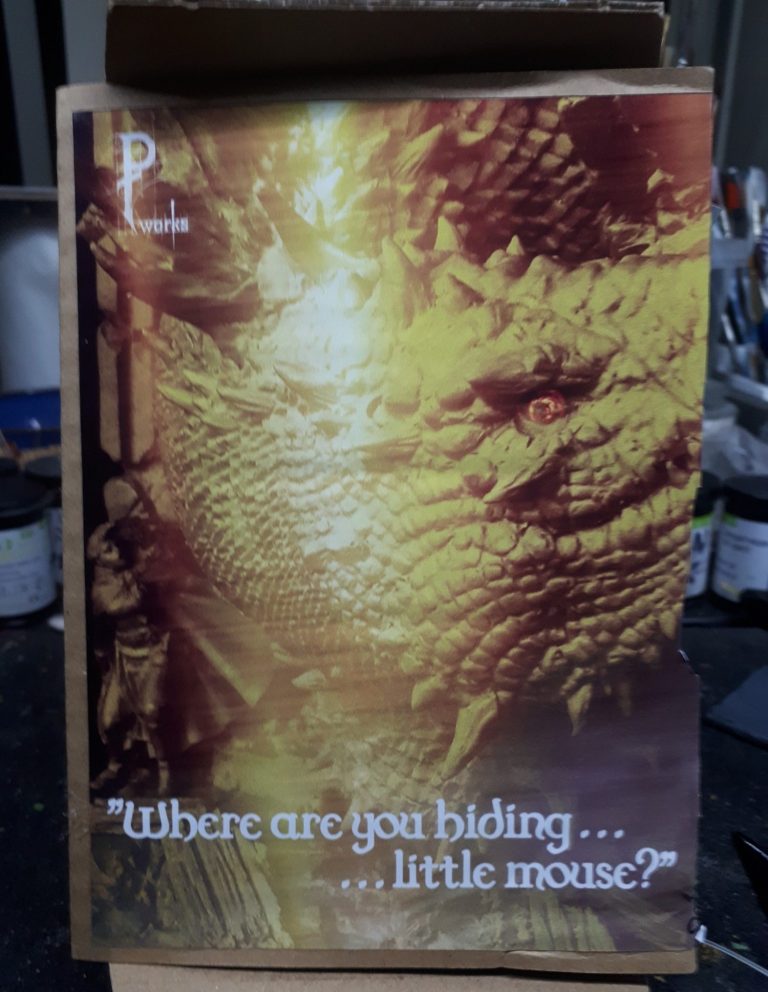
When I saw the initial release of this announced, I didn’t have to think, it was simply a case of “Please take my money”.
The concept and animation, not to mention the sculpting of the dragon – to me at least – was just a no-brainer, and I had to have one.
When the kit arrived, I was blown away with the quality of the main castings, although the tiny figure that is cowering to the left of the scene suffered from some mould shift, and I decided that it would possibly be replaced by something else.
The box art is shown in photo #1 along with the parts prior to assembly in photo #2, and you may be surprised, nay shocked I presume, to find that the model doesn’t end up half finished in the next picture.
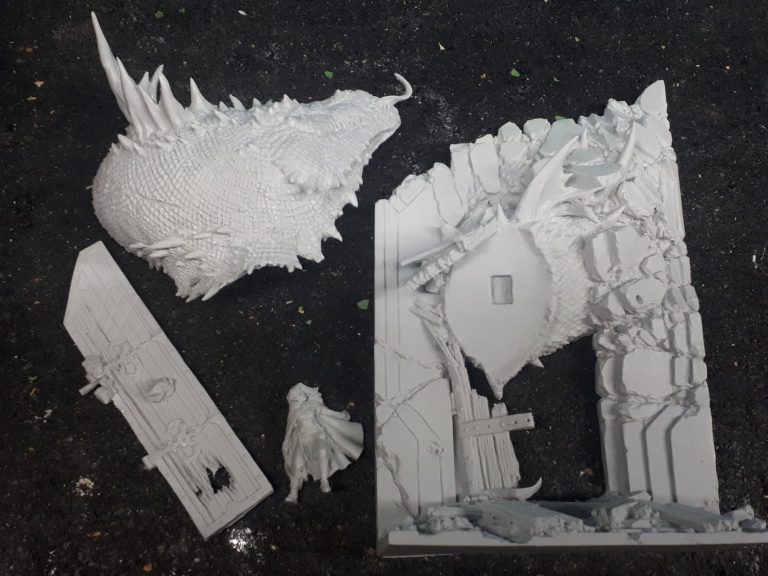

No !
In fact I had a whole host of ideas for this buzzing around my mind.
Of course I couldn’t resist using some blu-tac to temporarily fasten parts together – shown in photo #3, and doesn’t it just look superb ?
So, the ideas then…..
Photo #4 shows the idea of extending the scene out at the sides and to the front to allow for more figures to be added perhaps…..
And then I wondered if perhaps the scene could be done as a box diorama, with the onlooker being down a corridor and viewing the intrusion of the dragon.


Photo #5 shows the mock-up for this, using a large piece of insulation with a hole cut out for the initial idea of the corridor.
Photos #6 and #7 show further possibilities for this plan, the addition of a larger scale dwarf mid-way down the corridor, and a half figure in the foreground – his lower body removed because of his close proximity to the front of the scene – and this would change the setting to one of Dungeon Adventurers being chased by the resident Dragon whose treasure they were trying to appropriate…..
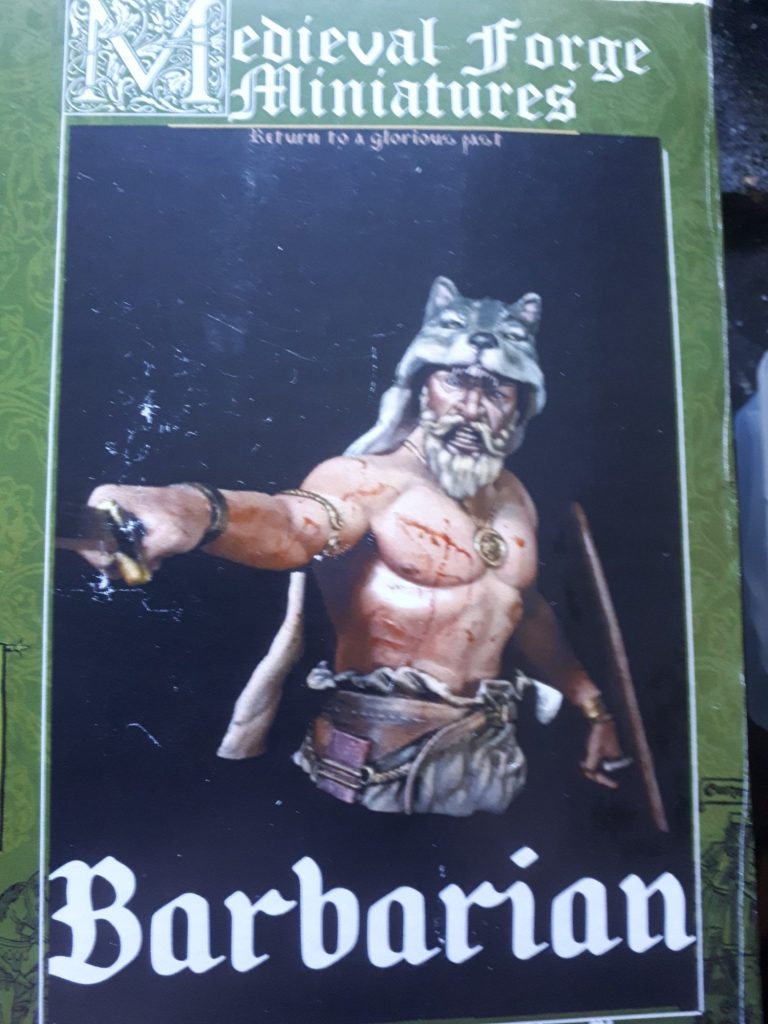

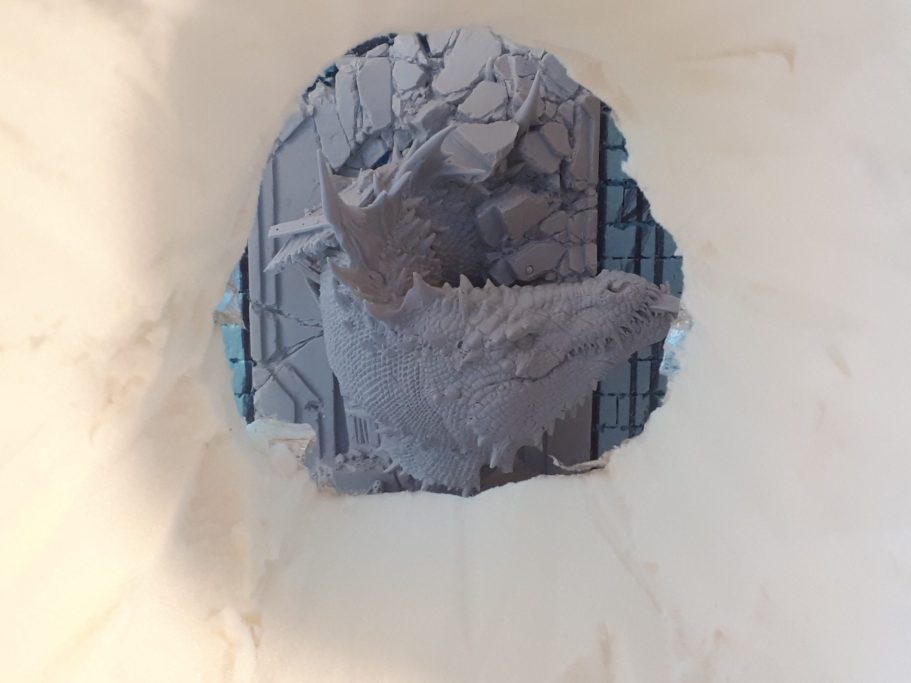
The problem was, as can be seen in photo #8, there is actually very little of the dragon breaking through the doorway that can be seen at the end of the corridor. I could add lighting to the back portion of the scene, but to be honest, I didn’t think it worked.
The idea was good, but the reality hid too much of a superb model.

Photo #9 shows a view from above the model, albeit with the extended groundwork still in place.
Although the kit looks great from the front, this shot shows how sharp a bend there is in the dragon’s neck, and how compact the scene is, so I considered sculpting a fillet of neck so that the dragon can be facing the front of the scene more.
Again, with further consideration, this wasn’t going to work, and I really questioned the “Why” of what I was trying to do here.
The old adage of “If it ain’t broke, why try to fix it” came into play here, and I felt I was trying to improve something that didn’t need improving.
With that thought, I could only really admit that I didn’t particularly like the small female thief figure that was included in the kit, I felt that if I was going to change anything it would be to remove her – simple enough as she is a separate part – and replace her with one or more GW metal dwarves from my collection.
In the meantime, why not add some paint to the focus of the scene and the background ?

Worthy of a quick look though is the casting of the dragon’s head and neck – photo #10. Ain’t it just superb ?
On the other hand, photo #11 shows the female thief figure, and it’s not a terrible casting, the sculpting is good, but I just wanted to make a change to the overall narrative of the scene.

Photo #12 – so while I set one of my few brain cells to work on what I was going to do, I turned my other brain cell to thoughts of adding some paint. The background shown in this shot is where I proposed to begin, leaving off the Dragon’s head so I could access the casting easily.

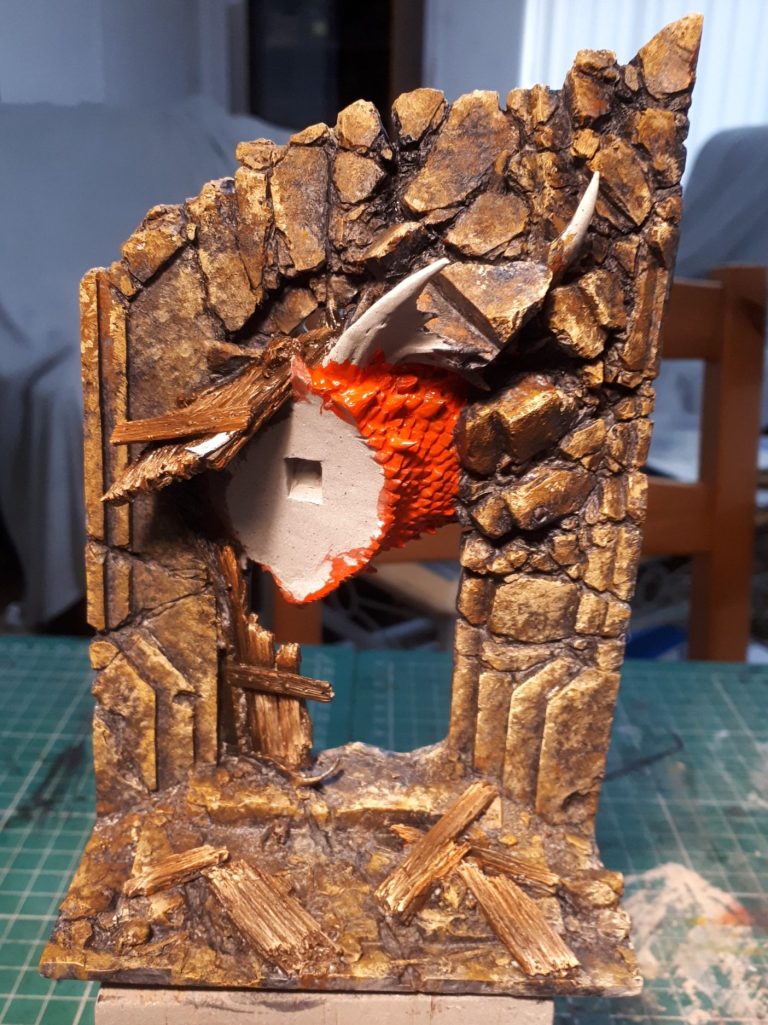
Photo #13 shows the main areas of masonry painted, I used a primer coat of Sand coloured acrylic, thinned with Isopropyl Alcohol and then added a couple of undercoat layers with more of the sand coloured acrylic, but thinned down with some water.
Once fully dry, Burnt Umber oils were added, having thinned the paint just a little with White Spirit to allow it to flow a bit, and enable me to get it into all the recesses of detail.
The excess paint is removed with a soft cloth, and then Mars Yellow followed by Titanium White is used to bring out mid-tones and highlights
To get a textured look to the stonework, I didn’t attempt to blend the colours together, stippling them on quite coarsely so that a distinct texture remained.
I’ve undercoated the neck of the dragon at this point too with MP ( Model Painter ) Crimson.
Photo #14 and time to work on the dragon scales.
With the masonry completely dry, along with the acrylic undercoat on the dragon’s neck I could make a mix of Carmine oils and White Spirit, thin enough to flow, but not so thin as to run all over in an uncontrollable manner. Imagine double cream as a consistency and you’ll not be far off.
This was painted onto the visible parts of the neck, and then put into the drying cabinet ( an old kitchen cupboard with a heating matt from a reptile vivarium in it ) to make some of the white Spirit evaporate.
A quick cuppa, maybe a biscuit or two and I could start adding some Scarlet oils to build up mid-tones and top those off with some Orange and finally Chrome Yellow.


Photo #15 hasn’t focused so well on the neck, but you can see that the addition of more Carmine, Scarlet and Orange oils has built up the colours on this portion of the neck. I’ve painted the horns on the spine too, these being done with a mix of burnt Umber, Mars Yellow and some Titanium White.
The crumbling masonry is in focus though, and there’s a lot of detail that can be brought out on this area. It’s something I would return to later.
Photo #16 shows the head….. Well, this is the side that actually won’t be seen once the dragon is assembled, but it’s good for a practice to show how the colours will work and also all that detail on the scales that’s there for the painter to play about with.
I’ve got to admit that it’s a pity this side of the head isn’t seen, or should I say, is difficult to see on the finished model. Once the details of the horns and larger scales are added, it really does look good.


Photo #17 and I couldn’t resist tacking the head in place, even though the “hidden” side isn’t complete and this side is only undercoated.
The only thing that struck me here was that I would definitely have to extend the base to be able to do what I wanted with replacing the supplied figure with a few dwarves.
Photo #18, and a view of how close the dragon’s head is to the background of crumbling masonry. There really isn’t much chance of seeing the painted detail on that side.


Photo #19 shows the side of the dragon that will be visible, and there’s a lot more room to add a pattern to the scales here.
I wanted to keep the red colouration, and so added darker triangles of colour to the lower half of the neck and highlighted the upper triangles with some orange.
At this stage the details haven’t really been dealt with, it was a case of blocking in the main colours and getting the pattern worked out.
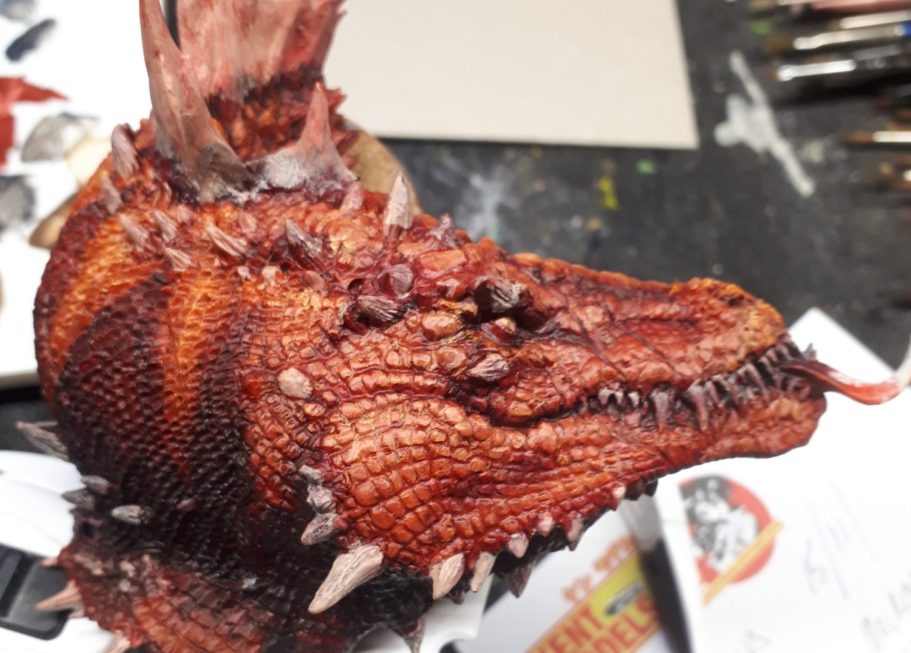
Photo #20 doesn’t look quite as eye-achingly bright, possibly because the paints have dried a little and possibly because the lighting is slightly different on my bench. These colours are more accurate to what the model looks like.
Still a lot of details to add in, the larger spines around the back of the jaw have been undercoated with a bone coloured acrylic, and the teeth and the spines along the dragon’s back will receive a similar treatment prior to adding oil colours.